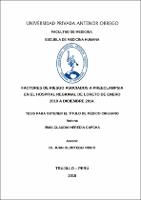Factores de riesgo asociados a preeclampsia en el hospital regional de Loreto de Enero 2010 a Diciembre 2014

View/
Download
(application/pdf: 1.129Mb)
(application/pdf: 1.129Mb)
Date
2015Author(s)
Heredia Capcha, Irma Claudia
Metadata
Show full item recordAbstract
El embarazo puede inducir hipertensión en mujeres previamente normotensas o agravar una hipertensión previamente ya existente. La preeclampsia tiene una incidencia entre 2% y 25% en diferentes partes del mundo. Se presenta predominantemente en mujeres con ciertos factores de riesgo, representando así una de las complicaciones graves más común del embarazo y es causa frecuente de morbimortalidad materna fetal y perinatal.
Objetivo: Determinar los factores de riesgo asociados a preeclampsia
Metodología: El presente estudio fue de diseño observacional y caso – control; de tipo transversal y retrospectivo. Los casos estuvieron constituido por las gestantes con pre-eclampsia atendidas y hospitalizadas en el Servicio de Gineco-obstetricia del Hospital Regional de Loreto durante los años 2010 – 2014, siendo los controles gestantes sin diagnóstico de cualquier enfermedad hipertensiva. Toda la información fue captada en una ficha de recolección de datos inferida de estudios previos y revisada por los asesores del estudio.
Resultados: En las preeclámpticas el 58,2% tenía de 20 a 34 años, encontrando OR > 1 en la edad menor de 20 años (OR: 3,008; IC: 1,499 - 6,037) y la edad mayor de 34 años (OR: 2,294; IC: 1,246 - 4,223). El 1,8% presentó IMC bajo, el 62,7% ÍMC normal, el 24,5% sobrepeso y el 10,9% fueron obesas, existiendo valor OR > 1 en las obesas (OR=5,265; Intervalo de Confianza: 1,806 - 15,355). Se encontró relación con la preeclampsia a la edad gestacional al momento del diagnóstico de < 37 semanas (x2=18,165; p = 0,00002) con OR > 1 (OR: 5,210; IC: 2,284 - 11,882), la nuliparidad (X2= 4,975; p = 0,026; OR=8,264; IC: 1,912 - 74,849), el embarazo múltiple (X2=12,957; p = 0,00031; OR=5,763; IC: 1,999 - 16,615), la diabetes mellitus preexistente o gestacional (x2=6,303; p = 0,012; OR=3,832; IC: 1,252 - 11,726), la Hipertensión arterial crónica (x2=32,954; p = 0.0000000094; OR=22,758; IC: 5,194 - 99,717), el antecedente familiar Enfermedad Hipertensiva (x2=6,306; p = 0.000000007; OR=6,306; Intervalo de Confianza: 3,202 - 12,419)
Conclusiones: Los factores de riesgo asociados a preeclampsia fueron la edad menor de 20 años, la edad mayor de 34 años, la obesidad, la edad gestacional al momento del diagnóstico de < 37 semanas, la nuliparidad, el embarazo múltiple, la diabetes mellitus preexistente o gestacional, la hipertensión arterial crónica y el antecedente familiar Enfermedad Hipertensiva. The pregnancy can induce hypertension in women before normotensas or
aggravate a before already existing hypertension. The preeclampsia has an
incident between 2 % and 25 % in different parts of the world. He appears
predominantly in women with certain factors of risk, representing this way one of
the serious complications more common of the pregnancy and is a frequent
reason of morbimortalidad mother foetal and perinatal.
I target: the factors of risk Determine associated to preeclampsia.
Methodology: The present study was of design observacional and case - control;
of transverse and retrospective type. The cases were constituted by the gestantes
with pre-eclampsia attended and hospitalized in the Service of Gineco-obstetrics
of Loreto's Regional Hospital during the year 2010 – 2014, Being the controls
gestantes without diagnosis of any hypertensive disease. All the information was
caught in a card of compilation of information inferred of studies previous and
checked by the advisers of the study.
Results: In the preeclámpticas 58,2 % was from 20 to 34 years old, finding OR> 1
in the age 20-year-old minor (OR: 3,008; IC: 1,499 - 6,037) and the major age of
34 years (OR: 2,294; IC: 1,246 - 4,223). 1,8 % presented low IMC, 62,7 % normal
ÍMC, 24,5 % overweight and 10,9 % were obese, existing value OR> 1 in the
obese ones (OR=5,265; Confidence interval: 1,806 - 15,355). One found relation
with the preeclampsia to the age gestacional to the moment of the diagnosis of
<37 weeks (x2=18,165; p = 0,00002) with OR> 1 (OR: 5,210; IC: 2,284 - 11,882),
the nuliparidad (X2 = 4,975; p = 0,026; OR=8,264; IC: 1,912 - 74,849), the multiple
pregnancy (X2=12,957; p = 0,00031; OR=5,763; IC: 1,999 - 16,615), the diabetes
mellitus preexisting or gestacional (x2=6,303; p = 0,012; OR=3,832; IC: 1,252 -
11,726), The arterial chronic Hypertension (x2=32,954; p = 0.0000000094;
OR=22,758; IC: 5,194 - 99,717), the familiar precedent Hypertensive Disease
(x2=6,306; p = 0.000000007; OR=6,306; Confidence interval: 3,202 - 12,419).
Conclusions: The factors of risk associated to preeclampsia were the age 20-yearold
minor, the major age of 34 years, the obesity, the age gestacional to the
moment of the diagnosis of <37 weeks, the nuliparidad, the multiple pregnancy,
the diabetes mellitus preexisting or gestacional, the arterial chronic hypertension
and the familiar precedent Hypertensive Disease.
Subject
Collections
- Medicina Humana [2969]

